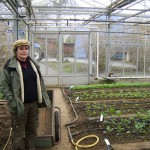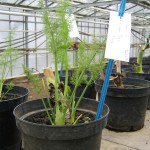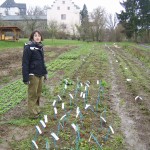Bingenheimer’s resident plant breeder, Ute Kirchgaesser, is on to something. Really, she’s probably on to many things, but to describe them all would take a book and I only have one blog posting.
Ute has what equates to a master’s degree in horticulture, but her German title sounds much better; Meistergartnerin. She got her start in plant breeding with a family run seed company where she learned the basics of traditional plant breeding, and has combined that knowledge with a more esoteric knowledge of an anthroposophical kind. All of these experiences combine to make her something more like and Ubermeistergarternerin if you ask me. But if you ask her, she is just a vegetable breeder.
Ute is working on developing a summer fennel. She is in the process of improving some leek varieties, and also is working to re-invigorate some old kales. She is in charge of the on-site seed production for Bingenheimer’s catalog. And she is also working on a project that even she can’t explain.
In 2002, she began to study what effect musical intervals have on plants. Previous studies have been done that show that plants respond well to classical music, and not so well to death metal. Ute wanted to know if a particular sequence of notes effects plants more than another, and she wanted to know if this effect can be seen in subsequent generations. She set up a research project working with some lettuces, which she surmised would show results quickly due to their rapid growth.
She began to play different intervals of two notes to different batches of lettuce seed before sowing. As a variation, she played to the plants during their initial stages of growth. She noticed some variation, but the changes were not as apparent as she had hoped.
Then she began working with dandelions (Taraxacum officinale). Ute’s anthroposophical background had taught her that different plants respond to different stimuli, well, differently. Dandelions were more open to external influences than most other plants, so the results should be more well defined. And they were. The results also varied from the results she obtained for the lettuce.
She documented very obvious changes, which only became more exaggerated in subsequent generations. These differences had to do with the growth habitat (vigor, arrangement and shape and size of leaves and flowers), strengths and weaknesses of the plants depending on which interval they had been treated with. Some presented their flowers earlier and lower to the ground. Some presented their flowers later, and significantly higher than the tallest leaves. Some plants had very vigorous deep roots, and some had shallower roots. And of course there were some in between. The most obvious changes, though, were found in leaf shape, with some plants presenting a traditional dandelion leaf shape, and some with leaves that were half stem, and some with leaves that were leafy and broad all the way to the root crown. And the variations were markedly along the lines in accordance to the interval that had been played to the seeds and/or young plants in previous generations.
A very interesting and obvious example of this was seen when the plants were all grouped together in a greenhouse in one gallon pots. The plants that had been treated with the fifth interval were almost destroyed by powdery mildew, and these pots were smack dab in the middle of plants treated with third and seventh intervals. In most cases powdery mildew spreads quickly to neighboring plants, especially in a greenhouse environment with little air flow and when the plants are very close together. But in this instance, the plants that were closely packed around the sick ones were not affected by the mildew. Interestingly, the powdery mildew plants produced the most vigorous seeds in the next generation.
Ute says she has a long way to go before her experiments can be drawn to any conclusions as to what the results mean. For now she is content to acknowledge that there are distinct and undeniable differences in plants that have been treated with certain intervals, and that the same interval affects different types of plants differently. At this point Ute is not sure if the variation is along family lines, ie brassicas (cabbages and radishes) vs. umbels (cilantro and parsnips), or if it is along plant type lines, as in root plants (carrots and beets) vs. leaf plants (kale and chard).
She hopes that her work will lay the foundations for work in the future, that will for starters discover if family or plant type has a stronger correlation to response to the intervals. Ute thinks if this type of research is carried out further, we may be able to use intervals in plant breeding to achieve desired traits in plants: for size, shape, flavor, color, or health benefits. At this point, she says, her results have raised far more questions than they have answered. Which must mean that she is on to something.
For some German stories about her projects, look here and here.



Very interesting! Of course the plants are listening… Check out the Dawn Chorus “Dan Carlson’s desire to see that no one need be hungry through shortage of food sought to understand the optimum growth of plants. His discovery was that plants also feed from ‘the top down’ as well as the roots. Underneath all leaves are pores called stomata which open to take in nutrients and moisture from the air. Carlson’s observation that the more bird life there is on the farm, the more abundant is plant life, has been echoed by farmers throughout history, except in modern times. Where there is little bird life, plants are stunted, dwarfed. Nature has the birds sing at dawn and dusk, which dilates the stomata, and so feeds the plants. One can immediately see the importance of trees.
The development of Sonic Bloom was to create birdsong, which is played to the plants, while a foliar nutrient is sprayed onto the plants at the same time as they are being stimulated by the sound, to enhance their growth . This method produced fantastic results in the amount of abundantly nutritious produce from one plant, often in poor soils and in drought conditions. Carlson showed that the breathing leaves of plants are the source of the nutrient intake for growth. This of course is also true for humans – the breath is food. We shall discourse on this at another occasion. Plants transfer nutrient to the soil via this breathing, and Carlson showed that his plants improved the soil and helped earthworms proliferate.” Source: http://newphysis.com/dawnchorus.html Cheers!